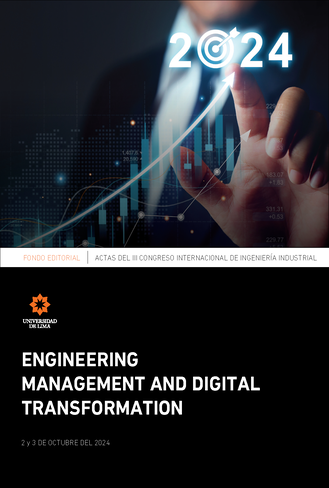Implementación de lean manufacturing, método sostac y machine learning para mejorar la gestión comercial en el sector de servicios
DOI:
https://doi.org/10.26439/ciii2024.7787Palabras clave:
sostac, 5S, machine learning, arima, lean manufacturingResumen
El siguiente estudio aborda las problemáticas de la gestión comercial y la falta de pronóstico de ventas en una empresa comercializadora de equipos de protección personal. El objetivo del estudio es implementar un modelo de mejora en la gestión comercial de una empresa del sector de servicios mediante el método sostac y con la integración de las 5S y el machine learning en el modelo arima. El tipo de investigación es aplicada, cuantitativa y descriptiva. Sostac y 5S, como herramientas de marketing e ingeniería, aportaron orden, gestión y control en el proceso de implementación del modelo en la organización para una gestión comercial rentable. Por otro lado, machine learning aportó un diagnóstico preciso de demandas futuras a través de la implementación del código arima. La muestra estuvo compuesta por datos de ventas de enero del 2020 a octubre del 2023. Se realizó un diagnóstico situacional, un análisis interno y externo, la identificación de procesos clave y la implementación de estrategias para la mejora de la gestión comercial. Los resultados indicaron una mejora en las ventas mensuales promedio (de S/ 12 648 a S/ 20 109,19). Asimismo, indicaron un incremento en la participación de mercado del 9,75 % al 10,81 %, una reducción de la brecha de eficiencia de la empresa con respecto al sector del 18,46 % al 13,60 %, y una mejora en la rotación de inventario de 2,7 a 3,62. Se concluye que la implementación del modelo propuesto, con el uso de las 5S y machine learning con arima, mejora significativamente la eficiencia, el volumen de ventas, la participación de mercado y la rentabilidad comercial, lo cual favorece el crecimiento y la sostenibilidad de la empresa.
Descargas
Referencias
Arana-Torres, R., Nieves-Asencio, A., Elias-Giordano, C., Torres-Sifuentes, C., & Cespedes, C. (2023, 4-6 de diciembre). Management model to increase sales through digital marketing and the 4Ps of marketing in a craft brewery. En Proceedings of the 3rd LACCEI International Multiconference on Entrepreneurship, Innovation and Regional Development "Igniting the Spark of Innovation: Emerging Trends, Disruptive Technologies, and Innovative Models for Business Success", 516. Latin American and Caribbean Consortium of Engineering Institutions. https://dx.doi.org/10.18687/LEIRD2023.1.1.516
Castro, P., Pathinettampadian, G., Ravi, C. S. D., & Subramaniyan, M. K. (2023). Prediction of compressive strength in additively fabricated part using long short term memory based neural network. Materials Today Communications, 37, Artículo 107139. https://doi.org/10.1016/j.mtcomm.2023.107139
Jara, B., Calderon, S., & Avalos-Ortecho, E. (2023). Application of lean manufacturing to increase productivity of a company in the metalworking sector. En L.-C. Tang (Ed.), Proceedings of the 10th Conference on Industrial Engineering and Applications (pp. 740-753). IOS Press. https://doi.org/10.3233/atde230102
Liu, X.-D., Wang, W., Yang, Y., Hou, B.-H., Olasehinde, T. S., Feng, N., & Dong, X.-P. (2023). Nesting the SIRV model with NAR, LSTM and statistical methods to fit and predict COVID-19 epidemic trend in Africa. BMC Public Health, 23(1), 138. https://doi.org/10.1186/s12889-023-14992-6
Marshall, D. R., Meek, W. R., Swab, R. G., & Markin, E. (2020). Access to resources and entrepreneurial well-being: A self-efficacy approach. Journal of Business Research, 120, 203-212. https://doi.org/10.1016/j.jbusres.2020.08.015
Ministerio de Trabajo y Promoción del Empleo. (2022). Notificaciones de accidentes de trabajo, incidentes peligrosos y enfermedades ocupacionales – Diciembre 2022 [Boletín estadístico mensual]. https://cdn.www.gob.pe/uploads/document/file/4327880/SAT_DICIEMBRE_2022.pdf?v=1679929130
Mishra, P., Al Khatib, A. M. G., Lal, P., Anwar, A., Nganvongpanit, K., Abotaleb, M., Ray, S., & Punyapornwithaya, V. (2023). An overview of pulses production in India: Retrospect and prospects of the future food with an application of hybrid models. National Academy Science Letters, 46(5), 367-374. https://doi.org/10.1007/s40009- 023-01267-2
Ramos-Valle, E., Paulino, A., Chavez, P., Alvarez, J. C., & Nallusamy, S. (2022). Pilot implementation of innovative proposal for service level improvement in a spare parts trading company. International Journal of Engineering Research in Africa, 62, 173-187. https://doi.org/10.4028/p-70sd0q
Seclen-Luna, J. P., Alvarez Salazar, J., Cancino, C. A., & Schmitt, V. (2024). The effects of innovations on Peruvian companies’ sales: The mediating role of KIBS. Technovation, 129, Artículo 102877. https://doi.org/10.1016/j.technovation.2023.102877
Shevchenko, V. M., Miamlina, A. V., & Kamenev, A. Y. (2021). Development of a model for the launch of a new goods in the herbicide group of the agrarian division “Bayer Cropscience” to the consumer market. Academic Review, 2(55), 48-58. https://doi.org/10.32342/2074-5354-2021-2-55-5
Sleiman, R., Mazyad, A., Hamad, M., Tran, K.-P., & Thomassey, S. (2022). Forecasting sales profiles of products in an exceptional context: COVID-19 pandemic. International Journal of Computational Intelligence Systems, 15(1), 99. https://doi.org/10.1007/s44196-022-00161-x
Smith, P. R. (1998). Marketing communications: An integrated approach (2.a ed.). Kogan Page.
Talkhi, N., Fatemi, N. A., Nooghabi, M. J., Soltani, E., & Nooghabi, A. J. (2024). Using meta-learning to recommend an appropriate time-series forecasting model. BMC Public Health, 24(1). https://doi.org/10.1186/s12889-023-17627-y
Thakur, M., Patel, P., Gupta, K., Kumar, M., & Sathishkumar, A. S. (2023). Applications of artificial intelligence and machine learning in supply chain management: A comprehensive review. European Chemical Bulletin, 12(8), 2838-2851. https://doi.org/10.13140/RG.2.2.29327.56480
Wang, R., Wang, T., Qian, Z., & Hu, S. (2023). A Bayesian estimation approach of random switching exponential smoothing with application to credit forecast. Finance Research Letters, 58, Artículo 104525. https://doi.org/10.1016/j.frl.2023.104525
Zhang, C., & Liang, J. (2023). Strategic choices for sustainable competitive advantage, marketization degree, and the executive-employee compensation gap. Sustainability, 15(8), 6430. https://doi.org/10.3390/su15086430


